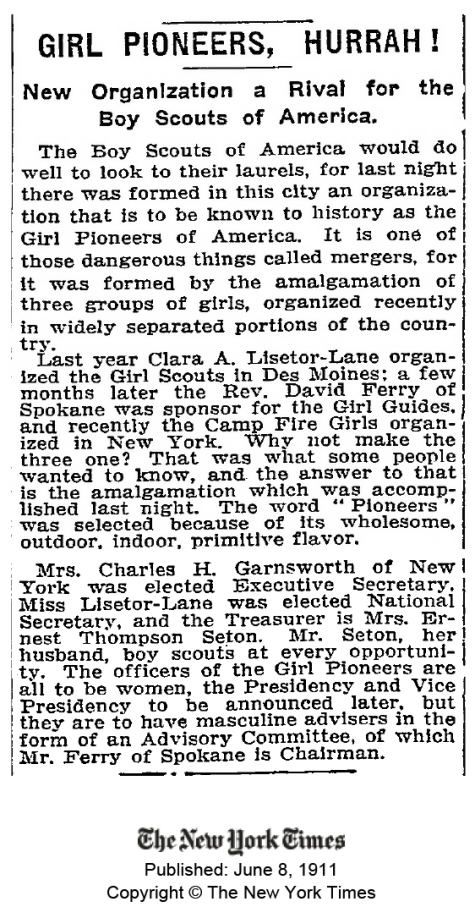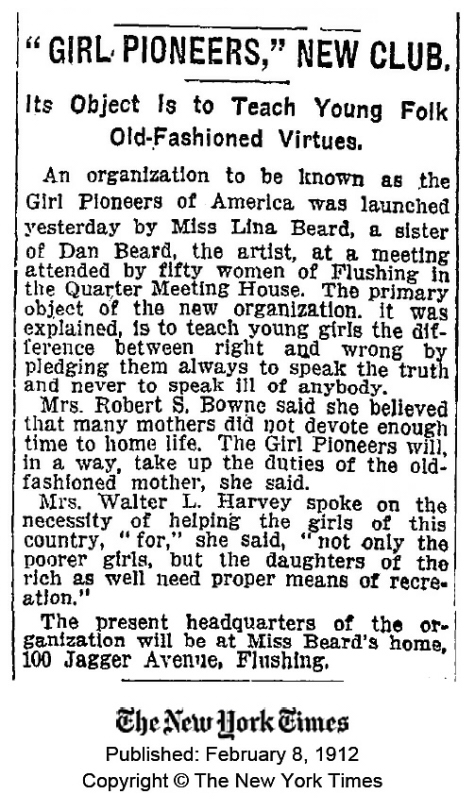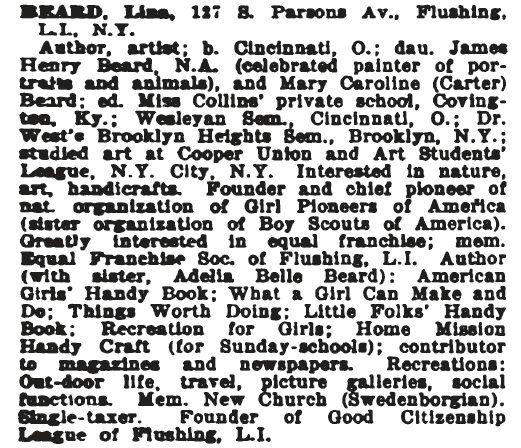| Historical origins
of Camp Fire - by Alice Marie Beard The organizational history and the story of the origins of Camp Fire are complex. There is the official version presented in the book Wo-He-Lo: The Camp Fire History, copyright 1980 by Camp Fire, Inc. Then there is the more complicated story of how the emergence of Camp Fire fits into the social picture of America. While the official version is accurate as far as it goes, the story is more complex than the official version, and more people deserve credit than only Dr. Luther H. Gulick (born 1865) and his wife, Charlotte Vetter Gulick (born 1865), the "official founders" of Camp Fire Girls. To understand the origins of Camp Fire, one must understand that, although Camp Fire does not carry the family name "Scouts," Camp Fire definitely is part of the scouting family in the USA. And to understand the origin of scouting in America, one must understand these two facts:
One also needs to realize that the various men involved in starting the Boy Scouts of America had wives and sisters, and that these various people knew each other, had frequent social interactions, and had social, professional, and educational relationships and friendships. With that in mind, a more complete list of the founders of Camp Fire Girls would include the following, in addition to the Gulicks:
Daniel Carter Beard's book The American Boy's Handy Book was published in 1882. The book was full of ideas for boys about how to have fun: kite making, fishing, camping, making boats, making water telescopes, raising wild birds, hunting, making spring guns, trapping, sledding, having snowball wars, putting on puppet shows, making magic lanterns, making snow-shoes. In short, how to have fun being a boy in the outdoors. Dan Beard had two sisters: Mary Caroline "Lina" Beard and Adelia Belle Beard. In 1887, five years after their brother's book was published, Lina and Adelia authored The American Girls Handy Book. Like their brother's book for boys, the Beard sisters' book was organized into seasonal activities. Subtitled "How to Amuse Yourself and Others," there were ideas for transplanting wildflowers, preserving the perfume of flowers, making Easter egg dolls, drying starfish, polishing shells, making corn-husk dolls and butterfly fans, painting china, entertaining, making candy. This was over 20 years before Boy Scouts officially began. Both books were popular and well received. A generation grew up with these ideas of youth recreation with nature and in the outdoors. In 1902, Ernest Thompson Seton began "Woodcraft Indians." He began the group because of something that had happened at his home in Connecticut in 1898: Some neighborhood boys had painted dirty words on his fence. He responded with forgiveness and invited the boys to camp on his property. From that camping experience grew Mr. Seton's "Woodcraft Indians." It was a group of boys learning outdoor skills and learning how to appreciate nature. Mr. Seton called that first group a "tribe" and added his own interpretations of Native American "flavor." In 1905, while Dan Beard was editor of Recreation magazine, he began a group for young boys called "Sons of Daniel Boone." Its purpose was to show boys how to have fun outdoors, to teach good citizenship, and to promote conservation. Mr. Seton frequently wrote of Native Americans, and he attempted to portray them accurately. For one of his books, he assembled a panel of Native American advisors, and this is where another player comes in: Dr. Charles A. Eastman, a physician whose medical degree was from Boston University Medical College and whose undergraduate degree was from Dartmouth. Before arriving at Dartmouth, Dr. Eastman had been known by the name "Ohiyesa." Dr. Eastman was a Sioux who had grown up on a reservation and became a fully licensed medical doctor. More later about Ohiyesa's contibutions to Camp Fire. For now, note that he began working for the YMCA in 1895. Back to the Gulicks: Dr. Gulick was a ranking official with the YMCA from at least 1890 until at least 1911. By 1910, Mrs. Gulick was developing a girls' summer camp in Maine on Lake Sebago. The Gulicks and the Setons were friends. With encouragement from Mr. Seton, Mrs. Gulick decided that Amer-Indian lore and Amer-Indian ceremony would permeate her camp. She named the camp "WoHeLo," the first two letters of the words "work, health, & love." While Mrs. Gulick was working with her Camp WoHelo in Maine in 1910, William Chauncy Langdon was helping the small town of Thetford, Orange County, Vermont, prepare for the celebration of the town's 150th anniversary that would happen in August 1911. Langdon wrote a pageant to be performed by the Thetford Boy Scouts, and the summer before the pageant was performed, Langdon's Boy Scouts were practicing and preparing for the pageant. The girls of Thetford wanted to be part of the activities also. Therefore, in advance of the pageant, Mr. Langdon organized the girls into a group as counterparts to the Thetford Boy Scouts. He created three ranks of achievement: Wood Gatherers, Fire Makers, and Torch Bearers, ranks still used in Camp Fire today. Langdon was a poet, historical writer, and playwright. His plays were historical dramatizations, each telling the story of the people in a particular community. He called his dramatizations pageants and saw them as "distinct and individual art forms." Pageant of Thetford was his first pageant. Helping Langdon with the planning for the 150th anniversary of Thetfort were, among others, Dr. Gulick, Ernest Thompson Seton, Professor Charles H. Farnsworth, Charlotte Alien Farnsworth, and Mary Schenck Woolman, all who were involved in one way or another with the formation of Camp Fire Girls. Langdon's connection with Dr. Gulick was close: The two worked together in New York City at the Russell Sage Foundation. Most folks are familiar with the YMCA, but few have heard of the Russell Sage Foundation. It was established in 1907 "to improve social and living conditions in the United States." Located in New York City, it is a research center and a funding source for studies by scholars -- a "think tank." Another detail to note is that Mr. Langdon, Mr. Seton, Mr. Beard, and Dr. Gulick all had a part in the planning of Boy Scouts of America. In June 1910, all four participated in a YMCA meeting trying to figure out the best way to spread the Boy Scout movement in America. All four were social and professional friends. Dr. Gulick was leading the YMCA during the time that the YMCA was helping Boy Scouts to begin in America, and Dr. Gulick was leading the YMCA in 1911 when another of the players became Chief Scout Executive of the newly formed Boy Scouts of America: James E. West, a young Washington, D.C., lawyer who had helped set up Washington's first juvenile court so that children would not be tried in adult courts. West lived in an orphanage from the time he was seven years old. He survived tuberculosis which left him partially disabled, and he worked his way through law school. As a young lawyer, a teenage boy stole his car. West's Christian response was to turn the other check, serve as the boy's lawyer in court, and successfully defend against the charge of auto theft. After the summer of 1910 -- when Mrs. Gulick ran her "WoHeLo Camp" and Langdon was preparing for the 1911 celebration in Thetford -- this collection of friends returned to work, most of them in New York City. Talk of the possibilities of a national organization for girls dominated talk at the Russell Sage Foundation, where Dr. Gulick and Langdon worked, and in the offices of the Boy Scouts of America, just across the street from the Russell Sage Foundation. The talk continued in the homes of this close group of friends and co-workers. On March 22, 1911, Dr. Gulick chaired a meeting "to consider ways and means of doing for the girls [nationally] what the Boy Scout movement is designed to do for boys." Among those present in the still small group were the Gulicks, the Farnsworths, Mr. Langdon, Mrs. Seton (Grace Gallatin), Lina Beard, and Mr. West (representing Boy Scouts of America). The name "Camp Fire Girls" was agreed on that day. "It was agreed that inquiries concerning boys' work be forwarded to the BSA and that they be asked to forward similar inquiries about girls' work to Camp Fire Girls. Dr. Gulick suggested that the officers of both organizations constitute a joint committee for matters of mutual interest." On April 7, 1911, a second meeting of the Committee on Organization was held. Soon after, an Advisory Committee was appointed with Mr. Farnsworth, Dr. Gulick, Mr. Langdon, and Mr. West of the Boy Scouts of America. Joining the committee a bit later were Mr. Seton and Mr. Beard. On April 10, 1911, Mr. West, in his job with Boy Scouts of America, issued the following press release from the Boy Scouts of America headquarters:
And two months later, on June 8, 1911, the following story appeared in the New York Times:
Surely
there was no "rivalry" with the Boy Scouts of
America, but the New York Times story shows two
things:
Second, the story shows that on June 7, 1911, the three small groups merged together and called themselves "Girl Pioneers of American." The officers of the newly formed group were named as Mrs. Charles H. Farnsworth, Miss Lisetor-Lane, and Mrs. Ernest Thompson Seaton. (In 1911, Mrs. Seaton's husband was extremely active in the newly formed Boy Scouts of America.) Langdon's Pageant of Thetford was performed on the banks of the Connecticut River, in Thetford, Vermont, on August 12, 14, and 15, in 1911. On page 61 of the Pageant, Langdon called the girls "the Girl Pioneers." And at page 62, describing Thetford, he wrote, "They've got Boy Scouts and Girl Pioneers everywhere." On February 8, 1912, the following story appeared in the New York Times:
The February 1912 news story used the same name, "Girl Pioneers of America," as the news story of eight months earlier. And Lina Beard was from the same group of folks who had been involved with sitting up what was called "Camp Fire Girls" in the BSA news release from ten months earlier (April 1911). And, in the William Chauncy Langdon's Pageant of Thetford that was performed only six months earlier (August 1911), Langdon had referred to "Boy Scouts and Girl Pioneers." According to Lina Beard's entry in a book with information assembled in 1913, Lina was "Founder and chief pioneer of nat. organization of Girl Pioneers of America (sister organization of Boy Scouts of America)." From page 87 of Woman's Who's Who of America: A Biographical Dictionary of Contemporary Women of the United States and Canada, 1914-1915, edited by John William Leonard, with preface to the completed book written on January 31, 1914:
Lina's sister Adelia Beard's entry (at page 86) includes this: "With sister, Lina Beard, worked out plans now embodied in the national organization of Girl Pioneers of America, sister organization to the Boy Scouts of America, and is executive secretary of the organization." In the same book, at page 730, Grace Gallatine Seton (Mrs. Ernest Thompson Seton) is described as "interested in Boy Scout movement and Camp Fire Girls of America." At page 904, for Mary Schenck Woolman (Mrs. Franklin Conrad Woolman): "Interested in the Camp Fire Girls." In other words, it appears that there was a brief time (from June 1911 to at least January 1914) when what ultimately was known as "Camp Fire Girls" was also known as "Girl Pioneers of America." In 1914, there was another major contribution to Camp Fire: Dr. Eastman, Ohiyesa, wrote the book Indian Scout Talks: A Guide for Boy Scouts and Camp Fire Girls. Both BSA and Camp Fire use Native American traditions. In recent years, there have been complaints from some of the "politically correct" that the use of such symbols and words was wrong and degrading to Native Americans. It should be noted that the person who offered those traditions to the two organizations was a Sioux with unimpeachable credentials: He grew up on a reservation, was the only physician there to give aid after the Wounded Knee disaster of 1890, and wrote biographies of some of the greatest Indian leaders of his lifetime. Ohiyesa's book written for Boy Scouts and Camp Fire Girls is filled with ceremonies, symbols, words, and names which he suggests as appropriate for use by the youth of the two groups. He wrote of how names were given to a person in his Sioux culture, and he suggested it would be appropriate for young people to create names meaningful to them. He included two lists. Above the first, he wrote, "The following are Sioux feminine names appropriate to Camp Fire Girls, with their literal and symbolic meanings." Then, he listed some Ojibway girls' names. Those same names have appeared in Camp Fire books since. James West retired from BSA in 1943. For all his years, Mr. West was a staunch supporter of Camp Fire Girls and was adament that Camp Fire Girls was the sister organization of Boy Scouts of America. Mr. West was such a strong supporter of Camp Fire Girls as BSA's sister organization that as Chief Executive of BSA he filed suit against Juliette Gordon Low's Girl Guide organization for using the word "Scouts" in the program as it was operated in the United States. Camp Fire continued as Camp Fire Girls thru the 1970s. Then, there was discussion between Boy Scouts of America and Camp Fire Girls to merge the two programs. During discussions, BSA began running some groups at the high-school age level that were coed. While the decision was against a merger, BSA continued running coed high-school groups which came to be known as Explorers. Camp Fire's decision after the discussions and trial runs was to go completely coed. After it became coed, the name was changed to simply "Camp Fire." Then, to "Camp Fire Boys and Girls." And more recently to "Camp Fire USA." At a banquet in New York City in 1910, Ernest Thompson Seton introduced British Lt. General Robert Baden-Powell as the "father of Scouting." Baden-Powell replied, "You are mistaken, Mr. Seton .... I may say that you, or Dan Beard, is the father - - there are many fathers. I am only one of the uncles." Baden-Powell acknowledged that much of what he wrote in his Scouting for Boys book was taken from Seton's The Birch-bark Roll of the Woodcraft Indians, and that the idea of having boys earn badges by meeting standards rather than completing against other boys was taken from Seton's program. Scouting was the creation of many, not one, and Camp Fire has been the creation of many, not only the Gulicks. Also, while Camp Fire does not carry the family name "Scouts," Camp Fire is defintely part of the family. Wo-He-Lo! |
||||||
email Alice |


